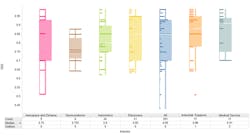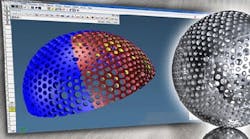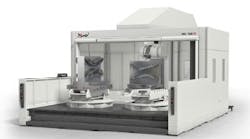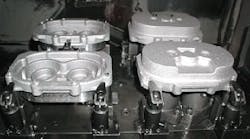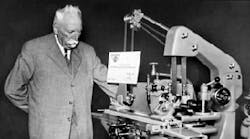Too many shops are put-off by the cost of tooling, and unaware of how tooling might affect throughput and product quality. Across all types of manufacturing industries, the cost of tooling represents about three percent of total production costs. However, this three percent of costs has a significant impact on cost per part and profits.
Three factors associated with tooling affect the cost to produce parts:
• The cost of the tools.
• How long they last before they must be replaced. • And, how effective they are at cutting.
An increase in cutting speed that leads to higher metal-removal rates is the most effective way to lower the cost of machining parts.
For example: A 20 percent increase in cutting tool speed reduces component costs by 15 percent. Compare that with the fact that a 30 percent decrease in cutting tool price, or a 50 percent increase in cutting tool life produce only a one-percent reduction in component costs.
The technology of tooling has changed dramatically in the past 10 years, allowing cutting speeds to nearly triple and producing similar improvements in productivity.
Many shops are having trouble keeping up with these advances. They are experienced and comfortable at producing parts a certain way and unsure about how to make process changes that might reduce cycle times. Also, few shops have the time, resources or the expertise to conduct in-depth analyses of their processes and investigate alternative solutions.
Experts offer help
Tool manufacturers are anxious to share their expertise with customers to reduce cycle times and machining costs. For example, two years ago, Emuge Corp. (www.emuge.com) opened a 21,000-sq-ft Technical Center in West Boylston, Mass., that has an array of resources the company offers to manufacturers.
Peter Matysiak, president of Emuge, recognizes the dilemma facing shops trying to optimize their machining processes.
“Take the situation where a manufacturing engineer in industry is charged with determining the best tools for an application that requires milling, drilling, reaming and threading.
“Tooling technology today is very diverse and sophisticated concerning tool geometries and coatings. With all of this diversity, how in the world is a manufacturing engineer to determine the best tools for the job? Emuge has extensive knowledge when it comes to threading and milling parts. With our stock of over 6,000 sizes and configurations of taps, 1,500 different thread mills and more than 2,500 different end mills, we carefully examine a customer’s application to select the best tool for the job,” Matysiak said.
When an engineer is faced with a manufacturing challenge that involves unfamiliar materials, operations or tooling, he or she can partner with Emuge to find a solution.
With the technologies that the company is expert in – in this case, milling and threading – the best possible way to accomplish these tasks in an application can be found.
“We want customers to use our Technical Center to help qualify new tools and processes,” Matysiak said.
For example, a small Pennsylvania mold shop was looking for advice on how it could improve on the time and cost to produce a specific mold.
Emuge engineers started with a drawing of the mold and generated tool paths and cutting strategies to optimize the performance of a selection of recommended tools. The customer was impressed with the projected machining time and supplied a couple of blocks of material to verify that the recommendations would work.
At the Technical Center, Emuge cut the mold from a solid block of 50 Rc hardened H13 block of steel on a Hermle C30U 5-axis machining center within the projected time limits. The surface finishes produced were beyond the mold shop’s expectations, and this assured the shop that the mold could be produced profitably.
The shop now is using the machining program and machined parts produced with Emuge tools as part of its justification for the purchase of a new 5-axis machining center.
Other tooling manufacturers offer similar technical and process-development help and Matysiak offers this advice to take advantage of supplier expertise:
“When you are faced with tooling and process challenges, shops should seek out manufacturers with special expertise in specific tooling disciplines. In the case of Emuge and its Technical Center, this special expertise is in threading and milling.”
The collaboration between Emuge and manufacturers started with large machine tool builders that supply the automotive industry. Those machine makers looked to Emuge for help in the development of threading processes on their machines.
Now, increasingly more CNC machine tool manufacturers and distributors recognize the value of specific tooling and process expertise in the development of turnkey machining processes.
Optimizing the cutting process
Several tooling manufacturers offer comprehensive programs that optimize the factors that contribute to shorter cycle times, including increased machining speed, reduced tool-change time and less scrap.
Sandvik Coromant (www.coromant.sandvik.com/us) has developed its Productivity Improvement Program (PIP) to help manufacturers improve overall profitability by increasing machining efficiency, reducing individual unit cost, eliminating bottlenecks and eliminating unnecessary wastes of time and materials.
Each Productivity Improvement Program is tailored to the special intricacies of a manufacturer’s operations and identifies the potential for improvement on a comprehensive level. Sandvik Coromant makes available the resources that are needed whether the partnering company wants to conduct a program on a cell, across a production line or throughout a plant.
A Productivity Improvement Program consists of four phases: Survey, recommend, confirm and implement.
During the initial survey phase, bottlenecks and areas of potential improvement are identified. The Productivity Improvement Program team gathers extensive data on targeted jobs, and the information is organized and analyzed.
During the recommendation and confirmation phases, members of the Productivity Improvement Program team take note of any potential improvements and determine which options would provide the best results. Possible solutions are tested out on the shop floor, and time and cost savings are recorded and presented to the partnering company. Productivity Analyzer reports are run to determine possible benefits.
During the final phase of a Productivity Improvement Program, the team helps to guide the implementation of changes on the shop floor. The partnering company selects which changes to implement. The Productivity Improvement Program team trains machine operators on new tooling and processes, and a productivity engineer follows up with the partnering company to ensure full realization of savings.
The partnering company only sees benefits if the recommendations generated by the Productivity Improvement Program are implemented. To implement the changes recommended, two key elements are involved – documentation and training.
Documentation is necessary to compare what is actually being run versus what the recommendations are. For instance, if the desired results are not being produced, documentation of the process is necessary to see if the recommended speeds and feeds are being followed, or if the recommended tooling is being used or if someone has somehow modified the process.
Also, process documentation allows the program to carry on with the partnering company regardless of personnel changes within the plant or with the Productivity Improvement Program team conducting the improvement program.
Training is conducted to be sure customer personnel understand all aspects of the new process, including the tooling, the grades, what product codes mean and how to troubleshoot.
Rick Hern, solutions team manger at Sandvik Coromant, said that management’s commitment to the process is critical to the success of the program.
“If the partnering company’s management understands the impact that tooling can make on speeding up machines and the bottom line, the recommended process changes are more likely to be followed,” Hern said.
A similar comprehensive program is offered by Seco Tools Inc. (www.secotools.com) that enables the measurement, control and management of manufacturing processes. The Excel-based PC program is called PCA (Productivity and Cost Analysis).
Productivity and Cost Analysis provides a wide view of manufacturing methods, focusing not just on the cost of tooling, but at the total cost of production.
With Productivity and Cost Analysis, Seco said it can evaluate a single machine tool process or the complete path a workpiece takes on its journey through a manufacturing plant. The latter takes bottlenecks or restraint operations into consideration, where more in-depth studies are necessary.
The Productivity and Cost Analysis software provides a comprehensive report with both process information such as tooling and cutting data, and cost information such as cost per part, output per hour, tool consumption and investment cost. It involves all parts of the production process, taking costs for tools, staff, premises, machines and workpieces into consideration.
A company that has used Seco Tools’ Productivity and Cost Analysis to its advantage is Avon Gear Co. of Rochester Hills, Mich. Avon Gear makes gears, shafts, housings and spline products for use in heavy equipment.
With more than 600 variants of complex parts produced in annual quantities that range from five to 80,000 pieces, new processes must be examined continuously and optimized.
The company said it has used Seco Tools’ Productivity and Cost Analysis to analyze costs and, by applying upgrades in tooling technology, has made substantial improvements in reduced cost and increased output.
“A Productivity and Cost Analysis done on a bevel gear proved that we could reduce our cycle time by 2.38 minutes per gear, getting more parts out the door in less time,” Aaron Remsing, president of Avon Gear, said.
“In addition to the savings in machine time, our tooling costs decreased by almost 90 percent annually. Improvements like this allow us to keep more work in-house and increase our profitability,” Remsing added.




